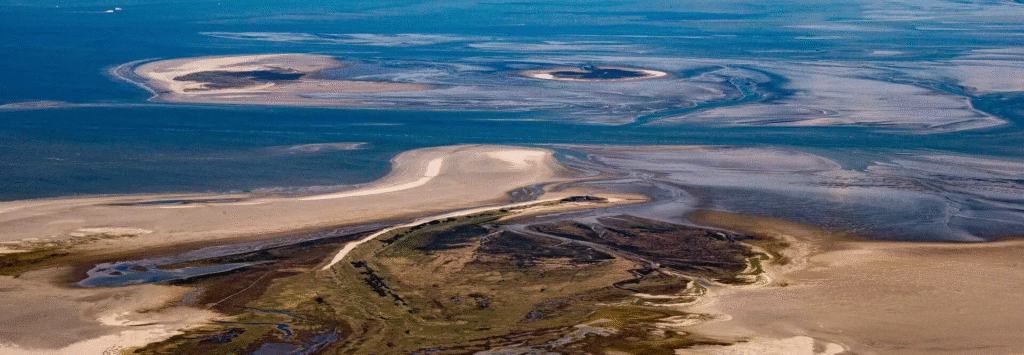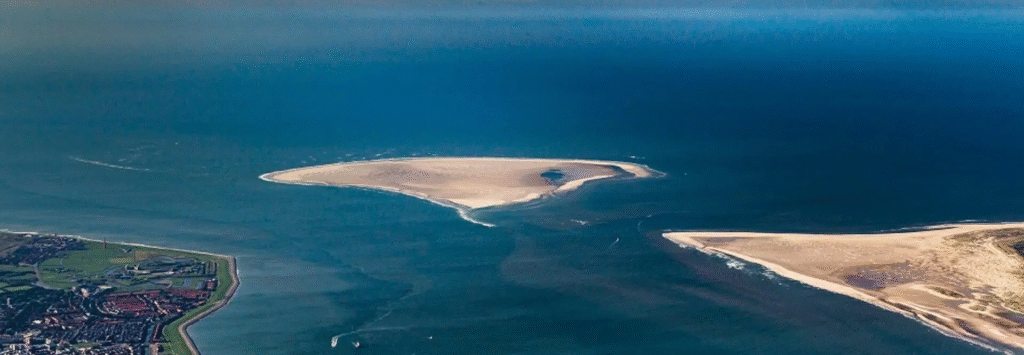Hidden pearls in the Wadden sea: discover the uninhabited islands of the Netherlands

Table of Contents
- No beach bars, just raw nature: welcome to the tranquil Wadden sea
- Untouched wilderness: the uninhabited islands of the Wadden sea
- Islands you can’t enter, but definitely should know
- Life with feathers and fins: who really calls the Wad Home
- The Wadden sea shifts, sighs and changes
- Not inhabited, but certanly not unknown
- Boots, binoculars and logbooks: guardians of the Wad
- Sand in the hourglass: climate on the Wadden
- Sailing the deserted islands — With wind, wonder and Lotus Sailing
No Beach bars, just raw nature: welcome to the tranquil Wadden sea
Besides the well-known inhabited Wadden Islands such as Texel and Ameland, there are also lesser-known, uninhabited islands scattered in the Wadden Sea. No terraces or beach clubs, but pure nature, silence and tens of thousands of birds. Welcome to the uninhabited Wadden Islands. They may be small, not touristy, but they play a gigantic role in the natural balance of the Wadden Sea. And to be honest: there is also something magical in such a place where man does not have the last word.
Untouched wilderness: The uninhabited islands of the Wadden sea
The uninhabited Wadden Islands may sound like something out of a pirate legend, but they are real – and they are in the Dutch Wadden Sea. No people, no roads, no WiFi (don’t be shocked): these islands are pure nature. They are not inhabited, but they are frequently visited by birds, seals and the occasional researcher in a trench coat. These places are crucial to the Wadden Sea ecosystem and are carefully protected. Think of them as the ‘silent forces’ of nature: you scarcely see them, but without them the system collapses like a house of cards.
Islands you can’t enter, but definitely want to know
Wondering who all are on Mother Nature’s guest list? Here come the silent stars of the Dutch Wadden area:
- Griend – Small but oh so important. A bird paradise south of Terschelling.
- Rottumerplaat and Rottumeroog – Eastern, rugged pearls with strict access policies.
- Razende Bol (Noorderhaaks)– Changes shape so often it almost looks like a living creature.
- Richel – Favourite sun spot of local seals.
- Engelsmanplaat – Tiny, but with a great reputation among migratory birds.
- Simonszand and Rif – Especially visible at low tide. A gift for the observant viewer.
- Zuiderduintjes – The name sounds cute (well, to the Dutch anyway), and they are…. at least, if you’re a bird.
Living with feathers and fins: who really calls these Wadden islands home
The uninhabited Wadden Islands are a true eldorado for bird watchers and nature lovers. During the breeding season, islands such as Griend and Engelsmanplaat are bursting with breeding birds: great terns, little terns, oystercatchers and spoonbills make quite a fuss. Meanwhile, common and grey seals sunbathe on Richel or Razende Bol as if they have booked a fancy wellness. And to think that all these animals are joined every year by hundreds of thousands of migratory birds from faraway countries. Clever creatures, who know exactly where to go to recharge their batteries.
The Wadden Sea is shifting, sighing and changing
The Wadden Sea is alive. Literally and figuratively. It is perhaps the only part of the Netherlands where you need a new map every year. The uninhabited Wadden islands and sandbanks are constantly moving under the force of wind, water and sand currents. Where there is still a dry sandbank during low tide, at high tide it is open sea again and vice versa. It is as if nature itself is doing a live update on Google Maps.
Take Rottumeroog, that quirky little island in the eastern Wadden Sea. That has been quietly moving towards Germany for years, as if it is itself ready for a new environment. The Razende Bol (Noorderhaaks) changes shape so often that even seasoned skippers occasionally doubt whether their compass still works. This natural sliding puzzle is not only fascinating but also essential.
New sandbanks emerge where birds can breed or seals can wash ashore at leisure. Other plates disappear, making room for currents that bring in nutrient-rich silt, which in turn benefits the whole ecosystem. In short: the Wadden Sea is not a stationary landscape, but a living painting. A little different every day. And that is precisely what makes it so special – and sometimes a bit unpredictable. But hey, that’s exactly what makes the Wadden so exciting, right?
Not inhabited but certainly not undiscovered
Although not permanently populated these days, the uninhabited Wadden Islands have not always been so quiet. Griend once had a small settlement, complete with a bird watcher’s cottage – a kind of one-person nature B&B, which is still there, by the way. Rottumeroog once even had monastery buildings, although now little remains of these but stories and some relics under the sand. Some islands were temporarily used for military exercises, others served as refuges for stranded fishermen. You would almost forget that these lonely places were once part of the human story. But now we gladly leave them alone – and rightly so.
Griend: where the bird watch lives (but just short of permanent)
Griend may be just a speck on the map of the Wadden Sea, but it is a speck with a story. A story that doesn’t include a village, a terrace or a campsite – but does include a lonely bird watcher’s cabin, right in the wind and surrounded by thousands of squawking seagulls. Sounds idyllic? Or just like a reality show without cameras.
This cottage, actually more of a simple wooden barracks, is not there for fun. For decades, bird watchers have been staying here during the breeding season to protect the island and its feathered inhabitants. They count nests, stop disturbances (read: nosy people with a drone) and live for weeks in complete isolation with the only neighbours being spoonbills, terns and petrels.
What makes it extra special: Griend is not an island you just walk onto. The barracks are on stilts, because at high tide, much of the island is under water. Comfort? Not really. Cellphone reception? Forget it. But for bird researchers, it’s a dream job – provided you like wind, silence and bird poop. Talking about the ultimate marriage test…

The lost monastery of Rottumeroog: monks’ work at the very edge of the Netherlands
Rottumeroog. Nowadays a deserted island where only the wind and birds have the final say. But in the Middle Ages? Back then, there was a real monastery here. Yes, a real spiritual refuge, built by monks who – quite literally – sought silence and seclusion. And where better to find that than on a sandbank at the edge of the world?
According to old chronicles, a monastic outpost was founded around the 13th century by the monks of the Benedictine monastery in Rottum (on the mainland). They came here to pray, work, AND keep an eye on the coast. Perhaps they even had a kind of medieval bird watch in habit.
Unfortunately, sacred life on the island did not last long. Storms, floods and an ever-changing landscape meant that the monastery literally and figuratively disappeared from the map. Today, nothing of it remains – except in stories, old maps and the mystery that still hangs over the island.
So yes, if you are ever cruising past Rottumeroog on a sailing ship and you suddenly feel a breeze with a hint of incense… who knows. Maybe a monk’s spirit is still watching somewhere or the wind is whispering an ancient psalm.
With boots and logbooks: how we monitor the Wadden
The Wadden Sea is not only a UNESCO World Heritage Site, but also an open-air laboratory. Organisations such as the Staatsbosbeheer, Natuurmonumenten and the Waddenvereniging keep a close eye on the islands. They monitor bird populations, bottom structures and seal populations. Many of the islands are off-limits to the public. Nature is literally given space here, and researchers are only allowed ashore with permission and respect for the ecosystem. Something not every skipper of the traditional sailing fleet agrees with. When you are just minding your own business on a sandbank and a whole bunch of seals decide they would like to be your neighbours for a few hours. Before you know it, you then have the well-meaning advice of a few ‘green lads’ hanging from your mast, but that aside.
Sand in the hourglass: climate on the Wadden Islands
When the water rises, the low-lying Wadden Islands are naturally among the first to get wet feet. So climate change is a big game changer. But the Wadden Sea also has a kind of superpower: it can adapt. At least, if we help it a bit. Through smart sand management, some plates can grow with the sea level. But that only works if we don’t get in our own way with dams, ports and human crowding. Without help, vulnerable spots risk disappearing – and with them, breeding sites, resting places and food-rich areas for birds and marine mammals.

Sailing the deserted islands: with wind, wonder and Lotus Sailing
Most uninhabited islands cannot be entered, but you can admire them from the water. Wad excursions, bird safaris and seal spotting tours take you there. Want to really experience it? Then join a traditional sailing ship from Lotus Sailing. During a relaxing sailing holiday, you will sail past sandbanks and hidden islands. Seals on Richel, terns on Griend – with a bit of luck, you will see them all. The skipper will tell you everything about life on the mudflats along the way. No crowds of people, no social media – just wind, water and wonder.

